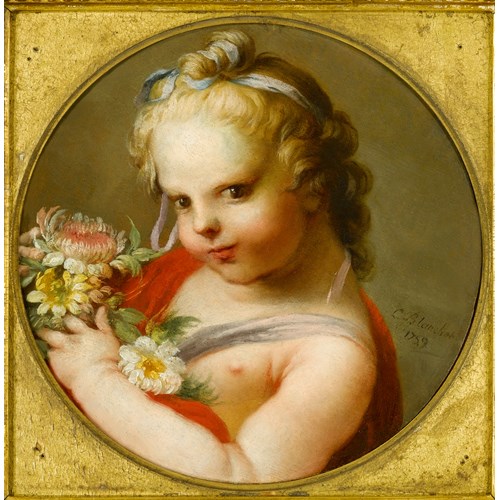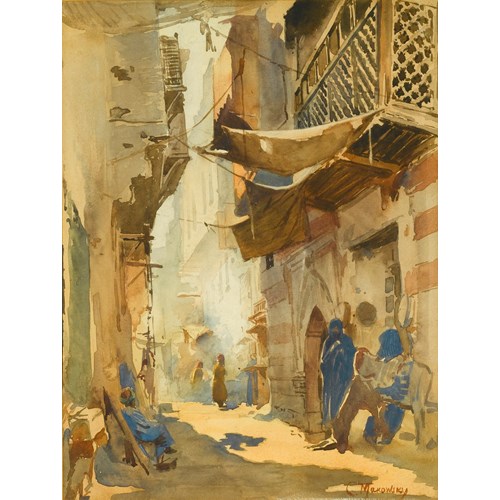Marketplace
Perseus and Andromeda
Lambert Sustris
Perseus and Andromeda
Date 1545
Period 1400-1600, 16th Century
Origin Italy, The Netherlands
Medium Oil on panel, trompe l'oeil shaped corners
Dimension 24.9 x 49.8 cm (9³/₄ x 19⁵/₈ inches)
This delightful panel is a beautiful addition to the ouevre of Lambert Sustris. It depicts Perseus freeing the naked Andromeda from the rock to which she has been tied, whilst the sea monster Cetus lurks nearby. In the background is the famed winged horse Pegasus, whom Perseus is often depicted with. Andromeda had been offered as a sacrifice to appease the monster, sent by Neptune to punish her mother’s boast that she and her daughter were more beautiful than the Nereids. Spotting the maiden chained to the rocks, Perseus killed Cetus and he and Andromeda were later married.
The composition of Perseus and Andromeda is set within an oval, and the trompe l’oeil shaped corners would suggest that this painting once formed part of a larger complex, perhaps a cassone-shaped panel, which may have been dismantled later.¹ Cassoni were Italian boxes or chests, regularly decorated with carving, gilding and painted panels. During the Renaissance, they were often made in pairs or groups of three and were frequently connected with a wedding dowry, as the bride would receive a cassone from her family on marriage. Such marital associations meant that the pictorial narratives often illustrated acts of heroism or love, such as in the present work.
The present work is a fine example of Sustris’ work, which demonstrates the multiple influences he absorbed into his style, and in particular the impact of Venetian art upon his work. The Rijksmuseum’s Nesus and Deianira, is a comparable work, in which the strongly horizontal composition is placed within a loosely defined landscape. In both works each figure group is clearly defined in its own space, so that the viewer can contemplate each part in isolation. Sustris’ interest in the nude is evident, and in both works the background shimmers with the same Venetian blue. Perseus and Andromeda has been dated c. 1545, and by this stage Sustris had spent a significant period of time living and working in Venice. The work bears the influence of many artists working in that city including Titian (c.1488/90-1576), Andrea Meldolla called Schiavone (1510-1563) and Bonifazio de’Pitati, called Bonifazio Veronese. The latter’s treatment of the same subject, also takes an oval format and features the same thin handling of paint. Both artists’ imagining of Cetus, as a winged dog blended with a serpent, is also comparable.
Sustris was trained in his native Amsterdam but moved to Italy in the early 1530s and, having visited Rome, is thought to have been in Titian’s studio in Venice by 1535. The characteristic thin, dry handling of paint which is a feature of Perseus and Andromeda, can also be seen in the background of Titian’s Presentation of the Virgin (Gallerie dell’Accademia, Venice).
Sustris is documented in nearby Padua in 1543, and seems to have spent a number of years working in that city. During this period, when the present work was executed, he developed a highly original and sophisticated style, which led to him becoming one of the leading exponents of Mannerism in the Veneto. Later in the decade he travelled to Bavaria, probably with Titian. Although his movements after this period are uncertain, it is thought that he returned to work in Venice. His son Friedrich Sustris spent most of his career in Germany, and became a leading exponent of Mannerism there.
We are grateful to Professor Peter Humfrey, for attributing the present work to Sustris and suggesting a date of execution of c. 1545.
¹ When the painting was sold in 1993 the painting was extremely dirty and the corners had been painted over.
The composition of Perseus and Andromeda is set within an oval, and the trompe l’oeil shaped corners would suggest that this painting once formed part of a larger complex, perhaps a cassone-shaped panel, which may have been dismantled later.¹ Cassoni were Italian boxes or chests, regularly decorated with carving, gilding and painted panels. During the Renaissance, they were often made in pairs or groups of three and were frequently connected with a wedding dowry, as the bride would receive a cassone from her family on marriage. Such marital associations meant that the pictorial narratives often illustrated acts of heroism or love, such as in the present work.
The present work is a fine example of Sustris’ work, which demonstrates the multiple influences he absorbed into his style, and in particular the impact of Venetian art upon his work. The Rijksmuseum’s Nesus and Deianira, is a comparable work, in which the strongly horizontal composition is placed within a loosely defined landscape. In both works each figure group is clearly defined in its own space, so that the viewer can contemplate each part in isolation. Sustris’ interest in the nude is evident, and in both works the background shimmers with the same Venetian blue. Perseus and Andromeda has been dated c. 1545, and by this stage Sustris had spent a significant period of time living and working in Venice. The work bears the influence of many artists working in that city including Titian (c.1488/90-1576), Andrea Meldolla called Schiavone (1510-1563) and Bonifazio de’Pitati, called Bonifazio Veronese. The latter’s treatment of the same subject, also takes an oval format and features the same thin handling of paint. Both artists’ imagining of Cetus, as a winged dog blended with a serpent, is also comparable.
Sustris was trained in his native Amsterdam but moved to Italy in the early 1530s and, having visited Rome, is thought to have been in Titian’s studio in Venice by 1535. The characteristic thin, dry handling of paint which is a feature of Perseus and Andromeda, can also be seen in the background of Titian’s Presentation of the Virgin (Gallerie dell’Accademia, Venice).
Sustris is documented in nearby Padua in 1543, and seems to have spent a number of years working in that city. During this period, when the present work was executed, he developed a highly original and sophisticated style, which led to him becoming one of the leading exponents of Mannerism in the Veneto. Later in the decade he travelled to Bavaria, probably with Titian. Although his movements after this period are uncertain, it is thought that he returned to work in Venice. His son Friedrich Sustris spent most of his career in Germany, and became a leading exponent of Mannerism there.
We are grateful to Professor Peter Humfrey, for attributing the present work to Sustris and suggesting a date of execution of c. 1545.
¹ When the painting was sold in 1993 the painting was extremely dirty and the corners had been painted over.
Date: 1545
Period: 1400-1600, 16th Century
Origin: Italy, The Netherlands
Medium: Oil on panel, trompe l'oeil shaped corners
Dimension: 24.9 x 49.8 cm (9³/₄ x 19⁵/₈ inches)
Provenance: Anonymous sale, New York, Sotheby’s, 20th May 1993, lot 11, as ‘Andrea Meldolla called Schiavone’;
Anonymous sale, London, Sotheby’s, 10th July 2008, lot 177, as ‘Andrea Meldolla called Schiavone’.
More artworks from the Gallery







, in a Green Dress and Pearls, Standing at a Draped _T638990626119457264.jpg?width=500&height=500&mode=pad&scale=both&qlt=90&format=jpg)

